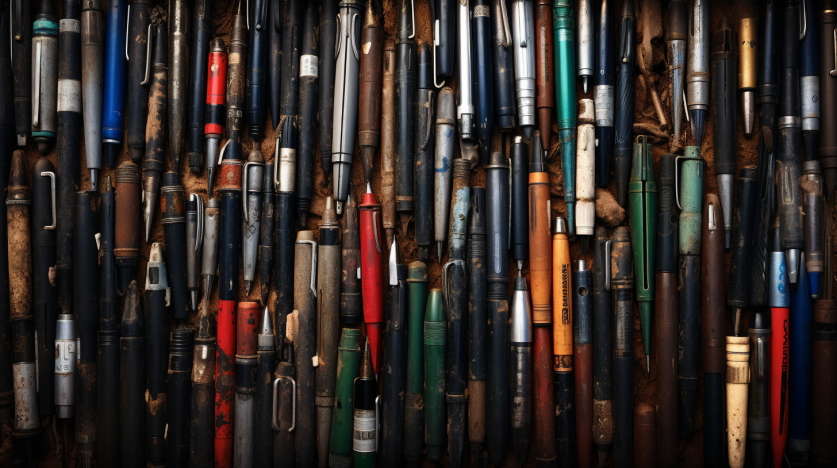Effective Solutions for Common Pen Maintenance Issues

Ironically, we live in a digital age, yet I’m here to talk about pens. I’m a seasoned pen enthusiast, and over the years, I’ve faced my fair share of pen-related issues. From stubborn nibs to irregular ink flows, I’ve seen it all.
But don’t fret, I’ve got effective solutions tucked up my sleeve. So, if you’re looking to conquer common pen maintenance problems, you’re in the right place.
Identifying Common Pen Problems
Kicking off our discussion, I’m going to highlight some common pen problems you’re likely to encounter.
Nib damage diagnosis is a critical first step. If your pen isn’t producing smooth lines, or if it’s scratching the paper, chances are you’re dealing with a damaged nib. Look closely for any visible cracks or bends, but be aware, damage could be microscopic.
Next, let’s discuss pen leakage solutions. If your pen is leaving unwanted blots of ink, it’s probably leaking. Check the ink reservoir and nib section for any loose fittings. If the issue persists, you may need to replace the reservoir or nib. Remember, proper pen maintenance isn’t just about aesthetics; it’s about ensuring your writing tool performs at its best.
Proper Cleaning Techniques for Pens
After handling nib damage and leakage issues, it’s essential I guide you through the proper cleaning techniques for pens to maintain optimal performance.
Cleaning pens routinely not only helps in their smooth operation but also extends their lifespan. The first step, naturally, involves removing any remaining ink. Once you’ve done that, it’s advisable to soak the nib in warm soapy water for a few minutes and then rinse under running water.
Drying techniques are equally important. I recommend using a soft cloth to gently wipe the nib, avoiding any harsh friction that could damage it. For hard-to-reach areas, a can of compressed air can be handy.
Lastly, ink selection plays a crucial role in pen maintenance. Always opt for high-quality inks as they’re less likely to clog the pen or cause other issues.
Tips for Unclogging Pen Nibs
Now, let’s dive into some practical tips for unclogging your pen nibs.
Understanding your nib materials is the first step. Steel nibs can withstand vigorous cleaning, but gold ones need gentle care. Use warm water and mild soap, but avoid hot water as it may warp the nib.
Next, consider the ink types. Dye-based inks usually clean out easily, but pigment-based ones may need a pen flush solution.
If the clog persists, try soaking the nib overnight. Remember, don’t force anything through the nib; it might damage it.
Lastly, maintain a regular cleaning schedule, even if you don’t use the pen much. An ounce of prevention is worth a pound of cure, as they say. So, keep those nibs clean and flowing smoothly!
Solutions for Ink Flow Issues
Dealing with ink flow problems in your pen can be a real hassle, but I’ve found several effective methods to tackle this issue head-on.
The first thing to consider is ink viscosity. If the ink is too thick, it won’t flow smoothly. I recommend using a less viscous ink or diluting the current ink with distilled water. Be aware that this may affect the color and drying time.
Another common issue is a faulty cartridge. Before assuming the worst, try a simple cartridge replacement. Often, a new cartridge can resolve ink flow issues. Just make sure it’s the right type for your pen.
Lastly, consistent cleaning can prevent clogging and promote steady ink flow. Remember, a well-maintained pen writes best.
Preventive Measures for Pen Longevity
Keeping your pen in top-notch condition isn’t just about dealing with problems as they arise; it’s also about taking preventive measures to ensure your pen’s longevity.
A key area to focus on is Nib Protection. It’s crucial to clean your nib regularly with lukewarm water to prevent ink clogs and to never use force when writing to avoid damaging the nib.
It’s equally important to consider Storage Methods. When not in use, store your pen vertically with the nib facing up to prevent ink from drying out in the feed. Using a protective case can also shield your pen from physical damage.
These measures may seem basic, but they’re paramount in maintaining your pen’s optimal performance and extending its lifespan.
Frequently Asked Questions
What Are the Best Pen Brands for Long-Term Usage?
In my experience, pen durability factors heavily into brand choice. Sustainable pen brands like Parker, Pilot, and Lamy are excellent for long-term use. They’re reliable, have quality refills, and can last a lifetime with care.
How Can I Repair a Cracked Pen Barrel?
To repair a cracked pen barrel, I’d first identify the barrel material. Then, I’d find a suitable adhesive that won’t damage it. For crack prevention, I’d avoid exposing the pen to extreme temperatures.
Are There Any Home Remedies for Removing Ink Stains Caused by Pens?
Yes, I’ve found some simple home remedies for removing ink stains. Using ink removal techniques such as rubbing alcohol or milk can be effective. Stain prevention strategies can also minimize future messes.
What Type of Ink Is Best for Different Types of Pens?
When choosing ink for various pens, it’s crucial to consider ink durability and composition. For fountain pens, water-based inks are best. Ballpoints prefer oil-based inks. Gel pens work well with gel-based inks.
Is There a Recommended Schedule for Changing Pen Nibs?
I’m often asked if there’s a recommended schedule for changing pen nibs. Really, it depends on nib quality and your writing style. Heavy users might need to change nibs monthly, while light users less frequently.
